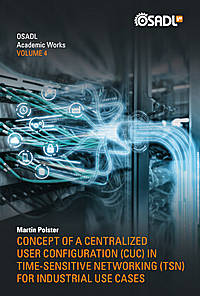Dates and Events:
|
OSADL Articles:
2023-11-12 12:00
Open Source License Obligations Checklists even better nowImport the checklists to other tools, create context diffs and merged lists
2022-07-11 12:00
Call for participation in phase #4 of Open Source OPC UA open62541 support projectLetter of Intent fulfills wish list from recent survey
2022-01-13 12:00
Phase #3 of OSADL project on OPC UA PubSub over TSN successfully completedAnother important milestone on the way to interoperable Open Source real-time Ethernet has been reached
2021-02-09 12:00
Open Source OPC UA PubSub over TSN project phase #3 launchedLetter of Intent with call for participation is now available |
OSADL Academic Works
Vol. 1: Linux in Safety-Critical Applications - Vol. 2: The SCART Hardware-Software Interface - Vol. 3: Hypervisor-Based Composable Systems for the Automotive Industry - Vol. 4: Concept of a Centralized User Configuration (CUC) in Time-Sensitive Networking (TSN) for Industrial Use Cases - Vol. 5: Statistical Path Coverage for Non-Deterministic Complex Safety-Related Software Testing
Vol. 4: Concept of a Centralized User Configuration (CUC) in Time-Sensitive Networking (TSN) for Industrial Use Cases
by Martin Polster
As a standardized communication technology, Ethernet is a fundamental component in industrial automation. However, standard Ethernet is still unable to cover automation technology with hard real-time requirements. Meeting the continually growing communication needs will require a uniform, manufacturer-independent communication network for real-time applications and best-effort data traffic. Therefore, the Time-Sensitive Networking (TSN) working group of the IEEE standardization authority is extending existing Ethernet standards to allow for real-time communication.
One of the configuration models defined by TSN is the centralized model. It provides information on communication requirements and available network resources centrally, so it is well-suited for complex use cases. It includes the Centralized Network Controller (CNC), Centralized User Configuration (CUC) and User/Network Interface (UNI) that handles communication between the CNC and CUC.
For the time being, the centralized model still lacks a coherent configuration process that takes the UNI into account. This book presents a solution to this shortcoming. Furthermore, the centralized model is compared to an alternative model with a distributed approach. It concludes that the centralized model is suitable for real-time applications with stringent low-latency requirements, while the distributed model offers greater flexibility when latency requirements are less stringent. The current development of a merged model aims to blend the advantages of both models and increases the potential of TSN for industrial applications.
About the author
Martin Polster graduated from the Friedrich-Alexander University Erlangen-Nuremberg with Master of Science degrees in Information & Communications Technology and in Computer Science in 2019. As part of his studies, he spent a semester abroad at Harvard University in Cambridge, USA, where he designed an evidence-based software package for the health care sector. He also holds a Bachelor of Engineering degree in Electrical Engineering and a Bachelor of Science degree in Industrial Engineering. During his studies, Martin began his career as a Development Engineer at Siemens AG in Erlangen where his focus was on hardware-related software for embedded systems. Among other things, this stimulated his interest in network communication for industrial products which, in turn, inspired this work.





